This content is archived from the Feline Nutrition Foundation
A Diet for Your Cat's Urinary and Kidney Health
- Updated: Saturday, June 01, 2019 05:37 PM
- Published: Friday, May 20, 2011 12:35 PM
- Written by Elisa Katz, DVM
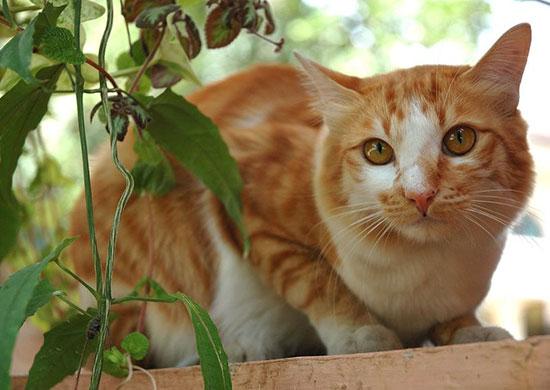 There is a connection between what cats are fed and what diseases they might get. This is an idea that is becoming much more widely accepted. Diet plays a role in disease syndromes such as kidney disease, urinary problems such as stones and crystals, Feline Lower Urinary Tract Disease and gastrointestinal problems such as IBD.
There is a connection between what cats are fed and what diseases they might get. This is an idea that is becoming much more widely accepted. Diet plays a role in disease syndromes such as kidney disease, urinary problems such as stones and crystals, Feline Lower Urinary Tract Disease and gastrointestinal problems such as IBD.
The kidneys regulate the water and salt balance in the body, maintaining hydration, electrolyte levels and regulating blood pressure. As proteins are metabolized by the body for energy, by-products are produced and circulated in the blood. It's the kidney's job to remove these toxic substances. Waste products such as urea nitrogen, creatinine and phosphorus, as well as certain drug metabolites, are all filtered from the blood and excreted in the urine. You may be familiar with the names of these by-products of protein breakdown if your cat has had blood work done. These are what are measured in the blood to detect declining kidney function – high levels mean that the kidneys aren't working normally. A complication is that the kidneys possess an amazing capacity for compensation. As much as 75% of kidney function must be lost before we can detect abnormally high blood values for these substances. Sometimes we see increased thirst and urination before the blood values rise above normal, as the kidneys become less able to conserve water, but not always. Since so much kidney function is lost by the time disease is usually detected, we need to do everything we can to help our cats maintain good kidney health in the first place.
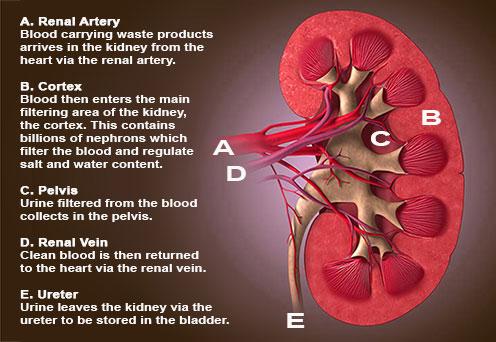 There are only a few definitively known causes for kidney disease. Genetic conditions such as polycystic kidney disease in Persian breeds, toxins such as anti-freeze and lilies, infections and cancer are all known to cause kidney disease. Much of the time, the exact cause is unknown, and a number of things may be contributing to impaired kidney function, including diet. Low-grade persistent bacterial infection in the bloodstream, such as that which occurs with advanced dental disease, may injure the kidneys over time. Preventing dental disease can be an important factor in the long-term health of your cat's kidneys. Other conditions that can cause harm to the kidneys include hypertension due to hyperthyroidism or other diseases.
There are only a few definitively known causes for kidney disease. Genetic conditions such as polycystic kidney disease in Persian breeds, toxins such as anti-freeze and lilies, infections and cancer are all known to cause kidney disease. Much of the time, the exact cause is unknown, and a number of things may be contributing to impaired kidney function, including diet. Low-grade persistent bacterial infection in the bloodstream, such as that which occurs with advanced dental disease, may injure the kidneys over time. Preventing dental disease can be an important factor in the long-term health of your cat's kidneys. Other conditions that can cause harm to the kidneys include hypertension due to hyperthyroidism or other diseases.
The type of diet you feed your cat can directly affect your cat's kidneys. Dehydration in cats causes the kidneys to concentrate urine to try to maintain the body's water balance. Concentrating urine predisposes a cat to renal injury.¹ The chronic, mild dehydration that cats experience when fed dry foods exclusively can cause increased stress on the kidneys, leading ultimately to decreased kidney function. Also, the low magnesium content in diets designed to decrease urinary stone and crystal formation may adversely affect the kidneys over time.²
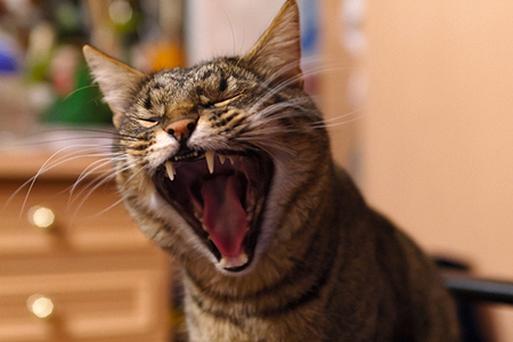 You may have been told to feed your kidney-compromised cat a diet that has a reduced protein content. Should you do it? Recent research demonstrates that diets high in protein have no detrimental effect on the kidneys, and animals with mildly decreased kidney function do not benefit from reduced protein diets.³ There is evidence that restricting protein may actually slow down the filtering action of the kidneys.⁴ It is important that cats receive good quality protein in appropriate amounts without excessive levels of phosphorous to help maintain kidney function. This means that the protein source should be from actual meat and not a meat meal. Meat meals can consist of mostly ground up connective tissue and bones. Usable muscle meat is removed before rendering, and so meat meals may contain high levels of calcium and phosphorous, which can harm the kidneys.⁵
You may have been told to feed your kidney-compromised cat a diet that has a reduced protein content. Should you do it? Recent research demonstrates that diets high in protein have no detrimental effect on the kidneys, and animals with mildly decreased kidney function do not benefit from reduced protein diets.³ There is evidence that restricting protein may actually slow down the filtering action of the kidneys.⁴ It is important that cats receive good quality protein in appropriate amounts without excessive levels of phosphorous to help maintain kidney function. This means that the protein source should be from actual meat and not a meat meal. Meat meals can consist of mostly ground up connective tissue and bones. Usable muscle meat is removed before rendering, and so meat meals may contain high levels of calcium and phosphorous, which can harm the kidneys.⁵
Rather than restricting protein that cats depend upon for their energy requirements, reducing phosphorus in the diet can help many cats with kidney disease. Phosphorous restriction is important in order to prevent the development of renal secondary hyperparathyroidism, a condition where excess phosphorous leads to an altered calcium/phosphorous balance. The end result of this imbalance causes calcium to be drawn from the cat's bones and deposited into the tissues and organs, including the kidneys, further impairing their function.⁶
Phosphorous limitation can be accomplished through the substitution of cooked egg whites for a portion of the meat in the diet, which dilutes the overall amount of phosphorus in the serving. Cooked egg whites are high in protein and very low in phosphorus. The phosphorous content of 100 grams of cooked egg white is 15 mg. For comparison, 100 grams of raw chicken has 198 mg of phosphorus and 100 grams of raw beef has 177 mg of phosphorus.⁷ Phosphorous binders can also be used. Binders are added to the food to prevent phosphorus from being absorbed into the body and bloodstream.⁸ A blood test is required to determine blood phosphorus levels, so you will need to work with your veterinarian to choose the best course. It is best to try to keep the phosphorous level in the blood to within the normal range or only slightly above.
Limiting protein is still sometimes used in cats with advanced kidney failure, but it has been my professional experience that diuresis helps these cats much more than protein restriction. Diuresis can be accomplished either at home with subcutaneous fluids or in the clinic with intravenous or subcutaneous fluids. Good hydration is a key element in helping cats with kidney disease. You can tell a human with kidney disease to be sure to drink plenty of extra water, but unfortunately you can't do that with your cat. We have to resort to other ways to accomplish extra fluid intake. Increasing water intake through food or, if necessary, through fluids given under the skin, can go a long way towards decreasing the stress on the kidneys and slow the progression of the disease.
Feline Lower Urinary Tract Disease
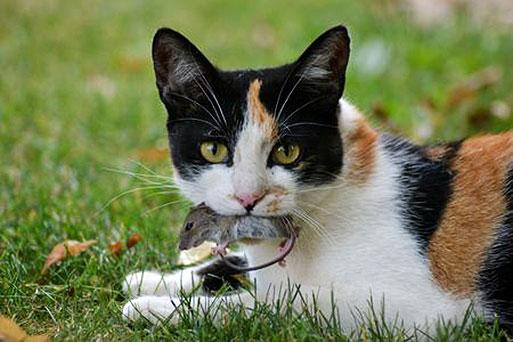 Water intake affects more than just a cat's kidneys, and kidney function plays a role in other urinary problems. As obligate carnivores, the normal instinctual diet of cats consists of prey animals that are high in protein, have moderate amounts of fat, and little if any carbohydrate. The typical prey animal for a housecat, usually a rat or mouse, consists of approximately 50 to 60% protein, 15 to 30% fat on a dry matter basis and 70 to 80% water. This indicates that 70 to 80% of the cat's natural instinctive diet should consist of water.⁹
Water intake affects more than just a cat's kidneys, and kidney function plays a role in other urinary problems. As obligate carnivores, the normal instinctual diet of cats consists of prey animals that are high in protein, have moderate amounts of fat, and little if any carbohydrate. The typical prey animal for a housecat, usually a rat or mouse, consists of approximately 50 to 60% protein, 15 to 30% fat on a dry matter basis and 70 to 80% water. This indicates that 70 to 80% of the cat's natural instinctive diet should consist of water.⁹
A quick search of any pet food website regarding the moisture content of most dry cat foods will tell you that they are generally only 8 to 10% moisture. Cats fed a dry diet exclusively are at a significant water deficit compared those eating a natural raw cat food diet. They are only consuming about 12 to 15% of their ideal daily water intake in their food. You may think that the cat can make it up by drinking more water, but cats innately have a low thirst drive, as they evolved to eat prey consisting of so much moisture.¹⁰
Feline urine tends to be more concentrated than urine of other mammalian species. This is one reason that the urine of intact male cats has such a strong odor.¹¹ The fact that cats produce such highly-concentrated urine, especially when fed low moisture foods such as kibble, makes them more susceptible to urinary crystals and stones and to urinary bladder irritation, a contributing factor to FLUTD. Basic chemistry tells us that the more concentrated a solution is, and in this case the solution is urine, the more likely any solutes are to precipitate out and form crystals and stones. The more concentrated the urine is, the more likely it is that it may irritate the delicate lining of the urinary bladder.
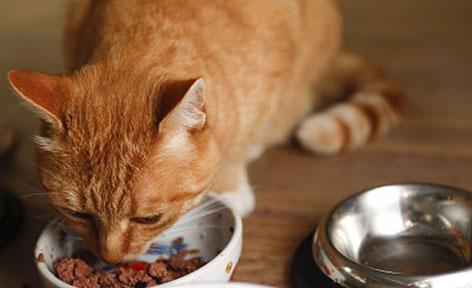 An important component of the recommended treatment of FLUTD is the feeding of canned food or raw cat food exclusively, which are about 70% moisture. This increases the cat's water intake, dilutes the urine and decreases the probability of crystals.¹² Raw cat food, which contain adequate moisture as well as appropriate amounts of protein and fat, can also help cats get back to a more natural urinary balance of pH and urine concentration. A study of the urine of 198 feral cats eating a natural, raw diet found no evidence of urinary stones in any of the cats.¹³
An important component of the recommended treatment of FLUTD is the feeding of canned food or raw cat food exclusively, which are about 70% moisture. This increases the cat's water intake, dilutes the urine and decreases the probability of crystals.¹² Raw cat food, which contain adequate moisture as well as appropriate amounts of protein and fat, can also help cats get back to a more natural urinary balance of pH and urine concentration. A study of the urine of 198 feral cats eating a natural, raw diet found no evidence of urinary stones in any of the cats.¹³
Recent research has suggested that higher protein in the diet may help to decrease the occurrence of struvite crystals and stones for two reasons. With increased protein, less magnesium is excreted in the urine, and the increased protein causes an osmotic diureses. Water is drawn into the kidneys and makes the cat urinate more.¹⁴ Additionally, "Dry cat foods with their high plant content, cause a very alkaline urine pH…This unnaturally high concentration of minerals and other constituents in the urine along with alkaline pH, leads to UTI (Urinary Tract Inflammation)."¹⁵
For my patients, I do not recommend the feeding of the special prescription diets that contain added synthetic substances to artificially control the pH of the urine. Treating urinary problems in this way may contribute to kidney disease, as recent evidence has suggested that the low magnesium content of these diets may have a detrimental effect on the kidneys over time.¹⁶
Dry cat food has only been around for about the past 70 years. During that time period, allergies, urinary problems, digestive problems and kidney disease in cats have all increased. This is in part due to better diagnostics and cats living longer, but it is my professional opinion that the widespread feeding of dry kibble diets plays a significant role.
Dr. Elisa Katz, DVM, is a graduate of Ohio State University and is the owner of Natural Pet Animal Hospital in Bourbonnais, Illinois. She practices holistic and integrative medicine focusing on proper diet and nutrition. Dr. Katz shares her home with four kitties and one dog.
1. Timothy A. Allen, David J. Polzin and Larry G. Adams, "Renal Disease," Small Animal Clinical Nutrition, 4th ed. Walsworth Publishing Company, 2000, 582.
2. K.L. Hughes, M.R. Slater, S. Geller, W. J. Burkholder and C. Fitzgerald, "Diet and Lifestyle Variables as Risk Factors for Chronic Renal Failure in Pet Cats," Preventive Veterinary Medicine,no. 55, 2002, 1-15.
3. D.R. Finco, S.A. Brown, C.A. Brown, W.A. Crowell, G. Sunvold and T.L. Cooper, "Protein and Calorie Effects on Progression of Induced Chronic Renal Failure in Cats," American Journal of Veterinary Research 59, no. 5, May 1998, 575-82.
4. Kenneth C. Bovée, DVM, MMedSc, "Mythology of Protein Restriction for Dogs with Reduced Renal Function," Supplement to Compendium on Continuing Education for the Practicing Veterinarian 21, no. 11, 1999, 15-20.
5. "The Biologically Appropriate Food Concept and the Dietary Needs of Dogs and Cats," ORIJEN White Paper, Proceedings, Purina Nutrition Forum, University of Pennsylvania, 1998.
6. L.A. Ross, D.R. Finco and W.A. Crowell, "Effect of Dietary Phosphorus Restriction on the Kidneys of Cats with Reduced Renal Mass," American Journal of Veterinary Research 43, June 1982, no. 6, 1023-6.
7. USDA National Nutrient Database for Standard Reference, Release 28, September 2015.
8. Peter J. Markwell, BSc, BVetMed, MRCVS, "Recent Advances in the Dietary Management of Chronic Renal Failure in Cats," Proceedings of the 23rd Waltham/OSU Symposium, 1999, 50-54.
9. Ellen S. Dierenfeld, PhD, Heather L. Alcorn, BS, and Krista L. Jacobsen, MS, "Nutrient Composition of Whole Vertebrate Prey (Excluding Fish) Fed in Zoos," U.S. Department of Agriculture, May 2002.
10. Michael W. Fox, Elizabeth Hodgkins and Marion E. Smart, Not Fit For a Dog: The Truth About Manufactured Dog and Cat Food, 2009, Quill Driver Books, 107.
11. A.D.J. Watson and H.P. Lefebvre, "Using Urine Specific Gravity,"International Renal Interest Society, 2007.
12. Peter J. Markwell, C. Tony Buffington and Brigitte H. E Smith, "The Effect of Diet on Lower Urinary Tract Diseases in Cats," The Journal of Nutrition, no. 128, 1998, 2753S-2757S.
13. Y. H. Cottam, P. Caley, S. Wamberg and W. H. Hendriks, "Feline Reference Values for Urine Composition," The American Society for Nutritional Sciences, The Journal of Nutrition, no. 132, June 2002, 1754S-1756S.
14. M. Hashimoto, M. Funaba, M. Abe and S. "Dietary Protein Levels Affect Water Intake and Urinary Excretion of Magnesium and Phosphorous in Laboratory Cats," Japanese Association for Laboratory Animal Science, Experimental Animals 44, no. 1, January 1995, 29-35.
15. Michael W. Fox, Elizabeth Hodgkins and Marion E. Smart, Not Fit For a Dog: The Truth About Manufactured Dog and Cat Food, 2009, Quill Driver Books, 107.
16. K.L. Hughes, M.R. Slater, S. Geller, W.J. Burkholder and C. Fitzgerald, "Diet and Lifestyle Variables as Risk Factors for Chronic Renal Failure in Pet Cats," Preventive Veterinary Medicine 55, no. 1, September 10, 2002,1-15.




